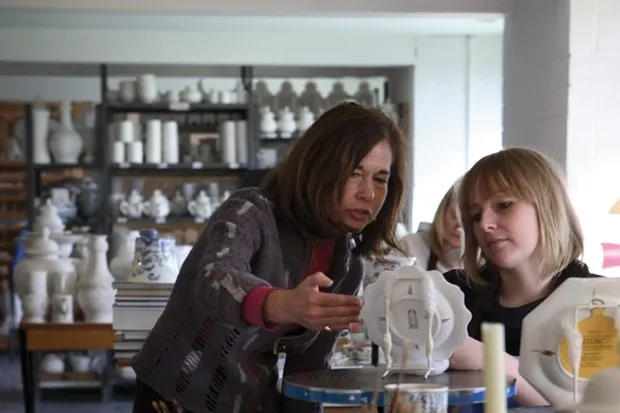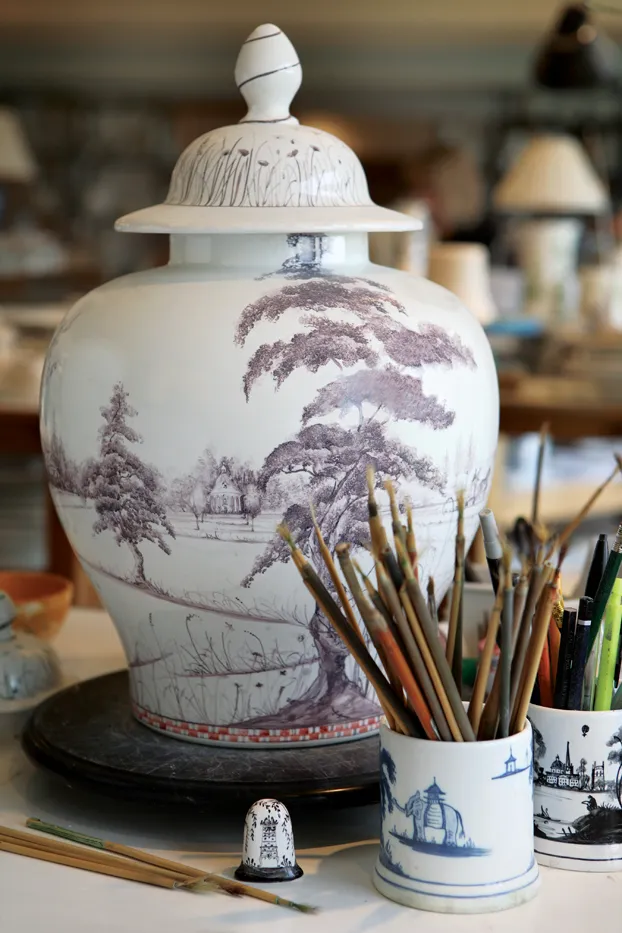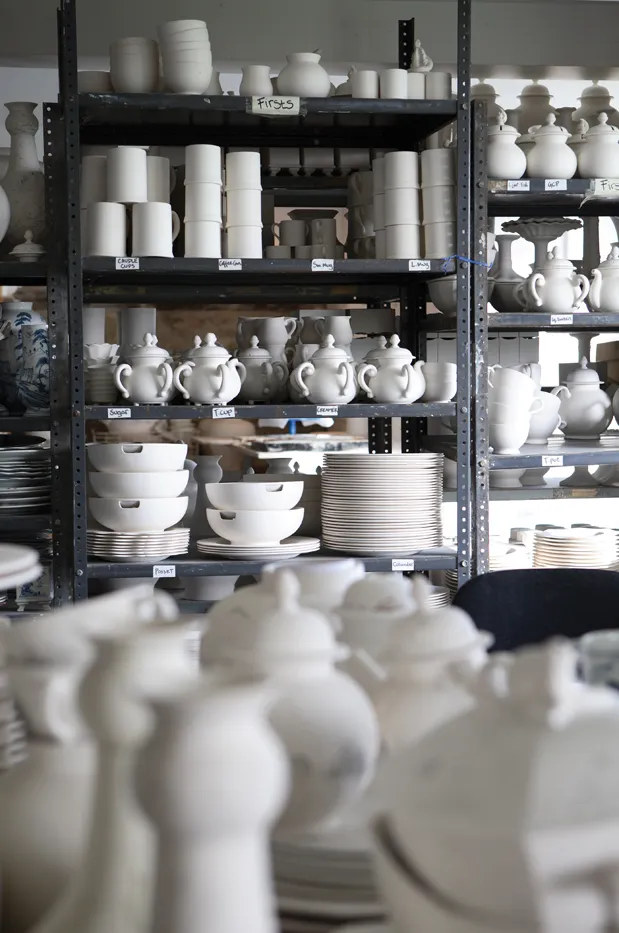Creativity starts early at the farmyard workshop of Isis Ceramics in Oxfordshire. From 7.30am the small band of painters and potters begins to arrive at the converted sheep shed to take full advantage of the natural light that streams in through floor-to-ceiling windows. Nipping over from the neighbouring farmhouse, owner and artist Deborah Sears unlocks the doors and puts the kettle on, ready for a new day of making the hand-painted, tin-glazed earthenware that has become her trademark.

In the adjoining showroom Deborah’s genteel range of ceramics is reminiscent of another age. Dishes have scalloped and fluted edges; there are sturdy rectangular and octagonal platters, quirky three-handled posset pots, chunky tureens, generous teacups, dainty coffee cans and delicate flower bricks. All are decorated with whimsical scenes of sailing boats, prancing horses or grand old houses, in a palette of blue, oxblood, sage green and manganese plum.
As you might expect, Deborah’s charming designs are rooted firmly in the past. She takes her inspiration from English Delftware – a type of hand-decorated pottery that originated in Delft, Holland, to rival Chinese blue and white porcelain – that was made from around 1620 to 1760 in London, Bristol and Liverpool. Original pieces are so special that they can fetch eye-watering prices. A marriage dish made at the Pickleherring Pottery in Southwark in 1650, discovered by the Antiques Roadshow’s John Sandon, recently sold for £54,000 at a Bonhams auction.

Deborah discovered English Delftware inadvertently in the early 1980s. ‘I was an American art student who had come to London to study and work. My grandmother sent me money to buy a turkey for Thanksgiving and I needed something to put it on,’ she recalls. She headed for Woolworths to buy a white plate but on her way she passed a charity shop where a blue and white platter caught her eye. ‘I loved the decoration on it and it only cost 50p, so I bought it.’
A distinguished dish
She thought nothing more of the provenance of her plate until a couple of Thanksgiving turkeys later (the second bird was so hefty it caused a crack to appear in the plate), when she was visiting the V&A. ‘I walked into a ceramics gallery and did a double take – there was my plate’s twin, labelled Liverpool Delftware and dated 1620.’
The remarkable discovery that her bargain platter was in fact an antique treasure and part of a wider craft tradition set Deborah on a quest to collect more pieces. ‘Part of the fascination,’ she says, ‘is that each painter has a different style – you can feel the energy of the person behind it. Pigments can’t be wiped off from the glaze, so the decoration has spontaneity of line.’
Her interest didn’t wane and a few years later, by then working as a graphic artist and living in Oxford with her husband Roger and two children, she decided to make some Delft-style tiles for her new kitchen. They were such a success that the kitchen company placed an order and in 1988, after a batch of Deborah’s Delft plates and bowls had been snapped up by the General Trading Company, Isis Ceramics was officially born.

From acorn to small oak, the pottery now has six staff, including four painters and a pottery technician. It makes a selection of signature ranges designed by Deborah such as ‘English Garden’, ‘Musical Monkeys’, ‘Nautical’ and ‘Exotic Animal’, and also offers a bespoke service to create personalised services, special pots and platters. Tailor-made ceramics are becoming increasingly popular and one set that will probably go down in history was created in 2006 for the Hon. Simon Howard, who lives with his family at Castle Howard in Yorkshire. ‘It was his 50th birthday present from all his family and friends,’ explains Deborah. ‘There are 30 different place settings, with seven pieces per setting, plus serving dishes – 300 pieces in all, depicting the house and estate. I went up there for two days to sketch and take photographs. A service such as this is a historical document for a family, with allusions that only they will appreciate.’
Another recent coup was the creation of large ginger jars for sale at the Prince of Wales’ newly opened Highgrove shop in Tetbury. ‘I visited Highgrove four times to sketch the wildflower meadow as it changed through the seasons.’
All in a day’s work
Deborah’s way of working is methodical. She sketches and photographs subjects and draws out designs on paper before transferring them using pencil onto a blank ceramic. Once the design is right she hand-paints it onto a ceramic body, moulded in the workshop, to create a template for her painters to follow. Sitting at her desk, serenely painting, with views over the sheep pastures outside, is her favourite task.

As with English Delftware of old, the painters work on pieces that have been biscuit-fired and dipped in opaque tin glaze. The painting is highly skilled and remarkably quick. ‘It’s all about touch – I can always tell who has decorated a piece,’ says Deborah. ‘When you’re painting you feel the weight of the stroke like a sound. It’s a rhythmic thing and you have to paint at speed to make the brush stroke look good.’
In technique there is little difference between Deborah’s modern-day Delftware and that made 300 years ago. She explains: ‘We can’t use lead in the glaze, so the colours are slightly different, but as a result our pieces don’t chip as much.’ She has also widened the palette of colours to include sepia, scarlet and cherry, and saffron yellow.
Deborah used to spend half her time in the studio, but now darts between developing designs and working on special projects. One recent challenge was to make a replica of an early English Delft wine bottle dated 1643-45, for an owner who sold it at auction (it made an incredible £52,580 – see above). ‘It bears the cipher of Queen Henrietta Maria, King Charles I’s wife, but is actually a second, a result of the kiln over-firing. The speckling effect has run and the image has blurred, so I had to try to make it go wrong!’ she smiles. ‘It was an organic process, but then every piece of English Delftware I’ve ever seen has its idiosyncrasies – that’s why I love it.’

COLLECTING ISIS CERAMICS
Roadshow expert Eric Knowles has long been an admirer of Isis
Eric Knowles first came across Isis ceramics in an interiors shop in Marlow, Buckinghamshire. ‘I looked in the window and initially thought, what great English Delft. It was so sympathetic and very like the Delft made around the 1750s. When the shop owner told me that the pieces were modern and made in Oxford, I made a mental note.’
Some years later in a shop in nearby Chesham he discovered an early English Delft wine bottle, with the moniker of Queen Henrietta Maria, which eventually sold for £52,580 at Bonhams. ‘The owner was reluctant to part with it, but I suggested he had a replica made by Deborah Sears, which he did.’
Will Isis pieces have staying power? ‘Quality will out,’ says Eric. ‘What Isis does, it does very well. The style of decoration is instantly pleasing and I love the fact that it’s entirely spontaneous – Deborah’s painters have to do it first time around. The naïve decoration is part of their charm and in step with earlier 18th-century pieces.’
FEATURE: Caroline Wheater
PHOTOGRAPHS: Lydia Evans